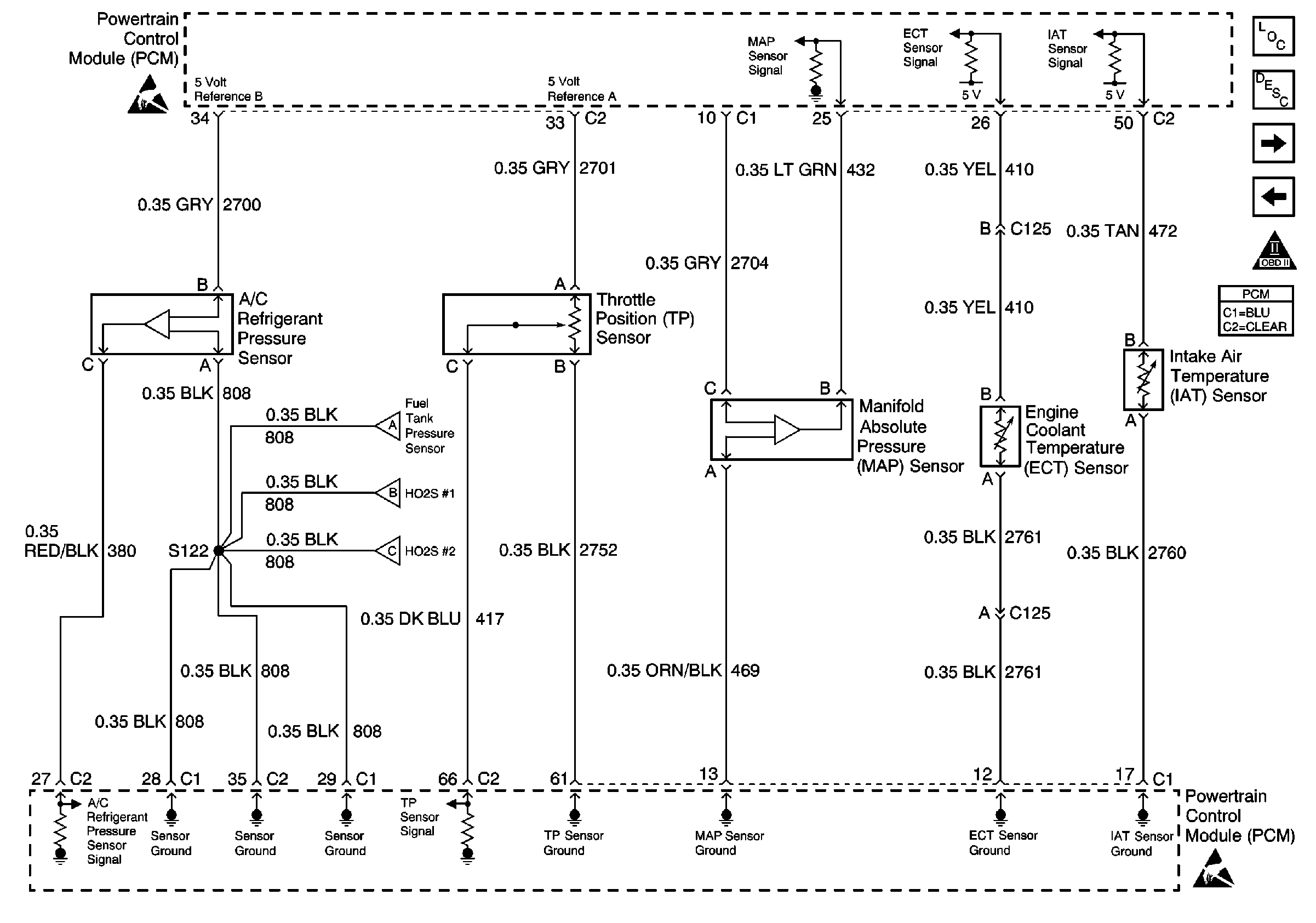Refer to Engine Controls Schematics
A/C Pressure Switch, TPS, MAP, ECT and IAT

.
Circuit Description
The throttle position (TP) sensor is a potentiometer. The TP sensor is mounted on the side of the throttle body. The TP sensor provides a voltage signal that changes relative to throttle blade angle. This signal voltage is one of the most important inputs used by the powertrain control module (PCM). The TP sensor has a 5.0 volt reference, a ground, and a signal circuit. The signal voltage varies from below 1 volt at closed throttle to about 4 volts at wide open throttle (WOT).
Conditions for Running the DTC
The engine is running.
Conditions for Setting the DTC
| • | The TP sensor signal voltage is more than 4.9 volts. |
| • | The above conditions are present for longer than 1 second. |
Action Taken When the DTC Sets
| • | The PCM illuminates the malfunction indicator lamp (MIL) on the second consecutive ignition cycle that the diagnostic runs and fails. |
| • | The PCM records the operating conditions at the time the diagnostic fails. The first time the diagnostic fails, the PCM stores this information in the Failure Records. If the diagnostic reports a failure on the second consecutive ignition cycle, the PCM records the operating conditions at the time of the failure. The PCM writes the conditions to the Freeze Frame and updates the Failure Records. |
Conditions for Clearing the MIL/DTC
| • | The PCM turns the MIL OFF after 3 consecutive drive trips during which the diagnostic runs and passes. |
| • | A last test failed, or the current DTC, clears when the diagnostic runs and passes. |
| • | A History DTC clears after 40 consecutive warm-up cycles, if no other emission related diagnostic failures are reported. |
| • | Use a scan tool in order to clear the MIL diagnostic trouble code. |
| • | Interrupting the PCM battery voltage may or may not clear DTCs. This practice is not recommended. Refer to Powertrain Control Module Description , Clearing Diagnostic Trouble Codes. |
Diagnostic Aids
Notice: Use the connector test adapter kit J 35616-A for any test that
requires probing the following items:
• The PCM harness connectors • The electrical center fuse/relay cavities • The component terminals • The component harness connector
Check for a malfunctioning TP sensor: With the ignition ON and the engine OFF, observe the TP Sensor display on the scan tool while slowly depressing the accelerator to wide open throttle (WOT). If a voltage over 4.71 volts is seen at any point in normal accelerator travel, replace the TP sensor.
If DTC P0123 cannot be duplicated, the information included in the Fail Records data can be useful in determining vehicle mileage since the DTC was last set.
If the problem is intermittent, refer to Intermittent Conditions .
Test Description
Numbers below refer to the step numbers on the diagnostic table:
-
Components that share the TP sensor 5 volt reference A circuit include the following devices:
-
This vehicle is equipped with a PCM that utilizes an electrically erasable programmable read only memory (EEPROM). When the PCM is replaced, the new PCM must be programmed.
| • | The exhaust gas recirculation valve (EGR) valve |
| • | The manifold absolute pressure (MAP) sensor |
| • | Disconnect these components one at a time while observing the TP sensor display on the scan tool. If the reading changes drastically when one of these components is disconnected, replace the component that affected the reading. |
Step | Action | Value(s) | Yes | No |
|---|---|---|---|---|
1 | Did you perform the Powertrain On-Board Diagnostic (OBD) System Check? | -- | ||
2 | With the throttle closed, observe the TP Sensor display on the scan tool. Is the TP Sensor display more than the specified value? | 4.7 V | ||
3 |
Does the scan tool indicate DTC P0123 failed this ignition? | -- | Go to Diagnostic Aids. | |
4 |
Is the TP Sensor display near the specified value? | 0 V | ||
5 | Probe the sensor ground circuit at the TP sensor harness connector with a test lamp connected to B+. Is the test lamp ON? | -- | ||
6 |
Was a problem found and corrected? | -- | ||
Was a problem found and corrected? | -- | |||
8 |
Was a problem found and corrected? | -- | ||
9 | Check for poor electrical connections at the TP sensor and replace the terminals if necessary. Refer to Testing for Intermittent Conditions and Poor Connections in Wiring Systems. Was a problem found and corrected? | -- | ||
10 |
Was a problem found and corrected? | -- | ||
11 | Replace the TP sensor. Refer to Throttle Position Sensor Replacement . Is the action complete? | -- | -- | |
|
Important: The replacement PCM must be programmed. Replace the PCM. Refer to Powertrain Control Module Replacement/Programming . Is the action complete? | -- | -- | ||
13 |
Does the scan tool indicate that this test ran and passed? | -- | ||
14 | Review the Captured Info using the scan tool. Are there any DTCs that have not been diagnosed? | -- | Go to the applicable DTC table | System OK |
